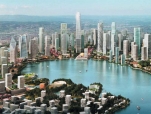Online Experiment

While China’s major cities already breaching the 10 million mark in terms of population (Shanghai is home to more than 16.6 million people, Beijing 12.2 million, and Shenzhen 9 million), leaders are looking to new cities as places to house the growing urban populations. Over half of China’s 1.3 billion people currently live in urban areas – a dramatic rise from approximately 30% of the population in the late 1970s. China’s urban population is expected to grow by an additional 350 million people over the next 12 years, and by 2030, well over 200 Chinese cities will be home to more than 1 million people each. This rate of urbanization brings increasing pressure on national, provincial and city leaders to accommodate massive amounts of people, and new cities are cropping up to absorb the country’s large number of urban migrants.
CHINA’S URBANIZATION:
International architecture firm Kohn Pedersen Fox Associates (KPF) has announced its 11 148 760 sq.m (120 million sq. f) master plan for Meixi Lake in Changsha, China is being realized. Meixi Lake is a new city in the West Changsha Pioneer Zone in Hunan Province, centered around a 3.85 kilometer-long lake. Upon completion, the city will be home to 180,000 inhabitants, and will provide residents, workers and visitors sustainable neighborhoods for living, working, recreation, culture and entertainment. While such new developments face challenges of homogeneity, organic interest or spatial variety, they also provide an unprecedented opportunity for governments, architects, developers and populations to design cities in innovative, thoughtful and sustainable environments.
A range of architectural housing typologies can provide inhabitants with different housing options, and historic lessons on the importance of mixed-use environments can be integrated at the outset of design. Flexible building typologies can provide employers and entrepreneurs with a range of commercial and office buildings, in order to respond better to the changing and growing demands for flexible work spaces. Technology and sustainable design measures are incorporated at all stages of master planning and development, making smart growth an inherent part of urban development. KPF Managing Principal Richard Nemeth adds, “Environmental sustainability is crucial to a city’s longevity.
China is growing beyond its environmental capacity and has limited natural resources and fresh water. Building a city’s infrastructure from scratch opened tremendous opportunities in this area. Water recycling in the city is centralized, waste is minimized through efficient building systems, urban agriculture and lake fishing provide a portion of the food, and methane is captured in the wastewater. We were able to rethink the typical urban elements that needed improvement and implement them in this completely new city.”
Full version you can download here
 Materials provided by Kohn Pedersen Fox Associates
Materials provided by Kohn Pedersen Fox Associates


